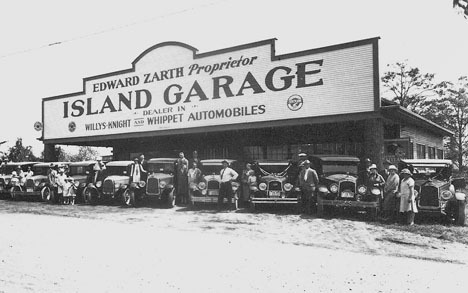In last week’s Beachcomber, Islander Roy McMakin suggested that Vashon Allied Arts provide greater transparency and community involvement regarding the arts campus it hopes to build at the corner of Cemetery Road and Vashon Highway, a visually historic Island intersection. I, too, think some discussion and debate about the future of that corner is in order — although it is with some trepidation that I write this, since I served on the VAA board that hired director Molly Reed and continue to be a huge supporter of Island artists.
I recently completed a historic survey of Center (the intersection of Cemetery Road and Vashon Highway) as part of a graduate-level preservation planning class. I’ve learned quite a bit about Center, as well as the historic planning challenges on Vashon.
The corner where McFeeds sits was originally the site of the Vashon Island Baptist Church built in 1883. A fellow by the name of Edward Zarth purchased the church and converted it into a garage. A fire in September 1926 destroyed the church/garage. Zarth rebuilt and opened his new garage with a car dealership in December 1926. Zarth was killed in a welding explosion in 1948 that damaged the back portion of the building.
Since 1948, the only significant changes to the structure have been the infill under the sign canopy and an addition of an office space to the south side.
This is the youngest of the three structures at the intersection. The Old Fuller Store dates back to 1885, and the Vashon Island Coffee Roasterie was built in 1884. Of course, there have been many changes to these structures.
Even so, for the past 83 years they have served as constant reminders of the Island’s rural agricultural past.
Historic preservation on Vashon has been challenging at best. Many longtime Islanders will remember the short-lived Burton Historic District. Community opposition to the district designation in 1990 ultimately led to the removal of three small homes to allow for the construction of the Back Bay Inn.
At the time, these buildings in Burton comprised the oldest visually intact rural intersection in King County. That honor now rests at the Center intersection.
The Island hasn’t added a building to the county’s historic landmark list since 1996.
The 1977-1979 historic survey of Island buildings turned up 48 potential historic structures (the Blue Heron Art Gallery and the Old Fuller store were included in this original survey), yet only 12 buildings are on the county’s landmark list.
There were originally 18 landmark trees noted in the 1996 Vashon Community Plan. Today only 10 remain, a loss of nearly 50 percent in just 13 years.
Islanders like to talk about preserving Vashon’s quality of life. This is evidenced in the debates over the K2 site, the Vashon Library, Glacier Northwest, the old Vashon Elementary School gymnasium, stop lights and bridges. Part of this quality of life consists of visual reminders of the Island’s rural agricultural past — driving or cycling past the open fields, the grand old trees and the buildings along the main highway.
What will become of the McFeeds building, should VAA bring its plans to fruition? A quick look at the Web site of LMN Architects, the firm VAA is interested in hiring, offers only photos of high-tech steel and glass structures.
Roy McMakin’s observation that significant tax dollars may be spent to modify or even destroy the visual context of this historic intersection should be given more thought and discussion.
It would be nice if VAA shared any sketches or ideas that have been used for fundraising purposes in order for Islanders to better understand the impacts of this new arts campus.
— Duane Dietz is a longtime Islander working towards a masters degree in historic preservation.



